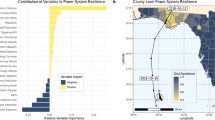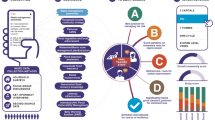Abstract
Managed retreat is a potentially important climate change adaptation option, providing an alternative to structural protection or accommodation measures to manage natural hazard risk. However, its application faces challenges given the projected scale of climate-induced displacement and the difficulties of resettlement. We evaluate the drivers, barriers and outcomes of 27 recent cases of managed retreat that have resettled approximately 1.3 million people. A conceptual model based on two key factors—who benefits from retreat and who initiates it—organizes the diverse set of cases into four quadrants. Different sociopolitical dimensions emerge as particularly influential in each quadrant. The model establishes a foundation for understanding and anticipating case-specific complexities. It can be used to unpack the landscape of managed retreat and evaluate its potential future applications.
This is a preview of subscription content, access via your institution
Access options
Access Nature and 54 other Nature Portfolio journals
Get Nature+, our best-value online-access subscription
$29.99 / 30 days
cancel any time
Subscribe to this journal
Receive 12 print issues and online access
$209.00 per year
only $17.42 per issue
Buy this article
- Purchase on Springer Link
- Instant access to full article PDF
Prices may be subject to local taxes which are calculated during checkout




Similar content being viewed by others
References
Nicholls, R. J. et al. Sea-level rise and its possible impacts given a ‘beyond 4 °C world’ in the twenty-first century. Phil. Trans. R. Soc. A 369, 161–181 (2011).
Wesselink, A., Warner, J., Syed, A., Chan, F. & Duc, D. Trends in flood risk management in deltas around the world: are we going ‘soft’? Int. J. Water Gov. 4, 25–46 (2015).
Wenger, C. Better use and management of levees: reducing flood risk in a changing climate. Environ. Rev. 23, 240–255 (2015).
Wong, P. P. et al. in Climate Change 2014: Impacts, Adaptation and Vulnerability (eds Field, C. B. et al.) 361–409 (IPCC, Cambridge Univ. Press, 2014).
Diaz, D. B. Estimating global damages from sea level rise with the Coastal Impact and Adaptation Model (CIAM). Climatic Change 137, 143–156 (2016).
Tsyban, A. et al. in Climate Change: The IPCC Impacts Assessment (eds Tegart, W. J. McG., Sheldon, G. W. & Griffiths, D. C.) (Australian Government Publishing Service, 1990); http://www.ipcc.ch/ipccreports/far/wg_II/ipcc_far_wg_II_chapter_06.pdf
Neal, W. J., Bush, D. M. & Pilkey, O. H. Encyclopedia of Coastal Science (Springer, 2005).
Esteves, L. S. Managed Realignment: A Viable Long-term Coastal Management Strategy? (Springer, 2014); http://dx.doi.org/10.1007/978-94-017-9029-1
Cooper, N. J. The use of managed retreat in coastal engineering. Proc. ICE Eng. Sustain. 156, 101–110 (2003).
Relph, E. Place and Placelessness (Pion, 1976).
Fullilove, M. T. Psychiatric implications of displacement: contributions from the psychology of place. Am. J. Psychiatry 153, 1516–1523 (1996).
Binder, S. B., Baker, C. K. & Barile, J. P. Rebuild or relocate? Resilience and postdisaster decision-making after Hurricane Sandy. Am. J. Community Psychol. 56, 180–196 (2015).
Roth, D. & Warner, J. Flood risk, uncertainty and changing river protection policy in the Netherlands: the case of ‘calamity polders’. Tijdschr. Voor Econ. Soc. Geogr. 98, 519–525 (2007).
Tobin, G. A. The levee love affair: a stormy relationship? J. Am. Water Resour. Assoc. 31, 359–367 (1995).
Niven, R. J. & Bardsley, D. K. Planned retreat as a management response to coastal risk: a case study from the Fleurieu Peninsula, South Australia. Reg. Environ. Change 13, 193–209 (2013).
Melius, M. L. & Caldwell, M. R. California Coastal Armoring Report: Managing Coastal Armoring and Climate Change Adaptation in the 21st Century (Stanford Law School, 2015); https://law.stanford.edu/publications/california-coastal-armoring-report-managing-coastal-armoring-and-climate-change-adaptation-in-the-21st-century
Schut, M., Leeuwis, C. & van Paassen, A. Room for the River: room for research? The case of depoldering De Noordwaard, the Netherlands. Sci. Public Policy 37, 611–627 (2010).
Turner, R. K., Burgess, D., Hadley, D., Coombes, E. & Jackson, N. A cost–benefit appraisal of coastal managed realignment policy. Glob. Environ. Change 17, 397–407 (2007).
George, A. L. & Bennett, A. Case Studies and Theory Development in the Social Sciences (MIT Press, 2005).
Rose, A. et al. Benefit-cost analysis of FEMA hazard mitigation grants. Nat. Hazards Rev. 8, 97–111 (2007).
Loss Avoidance Study (US Federal Emergency Management Agency, 2013); https://dps.mn.gov/divisions/hsem/hazard-mitigation/Documents/AustinLossAvoidanceStudy2013.pdf
Okada, T., Haynes, K., Bird, D., van den Honert, R. & King, D. Recovery and resettlement following the 2011 flash flooding in the Lockyer Valley. Int. J. Disaster Risk Reduct. 8, 20–31 (2014).
Sipe, N. & Vella, K. Relocating a flood-affected community: good planning or good politics? J. Am. Plan. Assoc. 80, 400–412 (2014).
de Vries, D. H. & Fraser, J. C. Citizenship rights and voluntary decision making in post-disaster US floodplain buyout mitigation programs. Int. J. Mass Emerg. Disasters 30, 1–33 (2012).
Rupp-Armstrong, S. & Nicholls, R. J. Coastal and estuarine retreat: a comparison of the application of managed realignment in England and Germany. J. Coast. Res. 236, 1418–1430 (2007).
Defra Coastal Pathfinder Evaluation: An Assessment of the Five Largest Pathfinder Projects (Defra, 2011); https://www.gov.uk/government/publications/coastal-pathfinder-evaluation-an-assessment-of-the-five-largest-pathfinder-projects
Barenstein, J. D. in Post-Disaster Reconstruction and Change (eds Barenstein, J. D. & Leemann, E.) 209–232 (CRC Press, 2012).
Boano, C. Housing anxiety and multiple geographies in post-tsunami Sri Lanka. Disasters 33, 762–785 (2009).
Bronen, R. & Chapin, F. S. Adaptive governance and institutional strategies for climate-induced community relocations in Alaska. Proc. Natl Acad. Sci. USA 110, 9320–9325 (2013).
McNamara, E. Cross-border migration with dignity in Kiribati. Forced Migr. Rev. 49, 62 (2015).
Zanolli, L. Louisiana’s vanishing island: the climate ‘refugees’ resettling for $52M. Guardian (15 March 2016); https://www.theguardian.com/environment/2016/mar/15/louisiana-isle-de-jean-charles-island-sea-level-resettlement
Adger, W. N., Kelly, P. M. & Locke, C. Migration, remittances, livelihood trajectories and social resilience in coastal Vietnam. Ambio 31, 358–366 (2002).
Ratha, D., Mohapatra, S. & Scheja, E. Policy Research Working Paper (World Bank, 2011); http://elibrary.worldbank.org/doi/abs/10.1596/1813-9450-5558
Adams, H. Why populations persist: mobility, place attachment and climate change. Popul. Environ. 37, 429–448 (2015).
Burley, D., Jenkins, P., Laska, S. & Davis, T. Place attachment and environmental change in coastal Louisiana. Organ. Environ. 20, 347–366 (2007).
Cernea, M. The risks and reconstruction model for resettling displaced populations. World Dev. 25, 1569–1587 (1997).
Ingram, J. C., Franco, G., Rio, C. R.-del & Khazai, B. Post-disaster recovery dilemmas: challenges in balancing short-term and long-term needs for vulnerability reduction. Environ. Sci. Policy 9, 607–613 (2006).
Learning From Megadisasters: Lessons From the Great East Japan Earthquake (World Bank, 2014); http://dx.doi.org/10.1596/978-1-4648-0153-2
King, D. et al. Voluntary relocation as an adaptation strategy to extreme weather events. Int. J. Disaster Risk Reduct. 8, 83–90 (2014).
Bukvic, A., Smith, A. & Zhang, A. Evaluating drivers of coastal relocation in Hurricane Sandy affected communities. Int. J. Disaster Risk Reduct. 13, 215–228 (2015).
Gillis, J. & Barringer, F. As coasts rebuild and US pays, repeatedly, the critics ask why? The New York Times (18 November 2012).
Ramsay, D., Webb, A., Abraham, S., Jackson, R. & Charley, B. Kosrae Shoreline Management Plan Repositioning for Resilience (National Institute of Water and Atmosperic Research Ltd, 2013).
UK Climate Change Committee Progress Report 2013: Managing the Land in a Changing Climate (Adaptation Sub-Committee of the UK Climate Change Committee, 2013).
Acknowledgements
We thank J. Barnett, V. Burkett, T. Chapin, K. Dow, R. Lempert, N. Mimura, B. Preston, A. Reisinger and A. Webb for feedback on an earlier draft. M.H. is financially supported through the Sykes Family Fellowship in Stanford’s Emmett Interdisciplinary Program in Environment and Resources. K.J.M. is supported by funding from the Alexander von Humboldt Foundation.
Author information
Authors and Affiliations
Contributions
M.H., K.J.M. and C.B.F. conceived the research and developed the conceptual model. M.H. collected and analysed data. M.H. wrote the paper with discussions with and inputs from K.J.M. and C.B.F.
Corresponding author
Ethics declarations
Competing interests
The authors declare no competing financial interests.
Supplementary information
Supplementary Information
Supplementary Information (PDF 412 kb)
Rights and permissions
About this article
Cite this article
Hino, M., Field, C. & Mach, K. Managed retreat as a response to natural hazard risk. Nature Clim Change 7, 364–370 (2017). https://doi.org/10.1038/nclimate3252
Received:
Accepted:
Published:
Issue Date:
DOI: https://doi.org/10.1038/nclimate3252
This article is cited by
-
Social consequences of planned relocation in response to sea level rise: impacts on anxiety, well-being, and perceived safety
Scientific Reports (2024)
-
Policy and market forces delay real estate price declines on the US coast
Nature Communications (2024)
-
Insurance retreat in residential properties from future sea level rise in Aotearoa New Zealand
Climatic Change (2024)
-
Municipal perspectives on managed retreat and flood mitigation: A case analysis of Merritt, Canada after the 2021 British Columbia flood disaster
Climatic Change (2024)
-
Managing retreat for sandy beach areas under sea level rise
Scientific Reports (2023)



